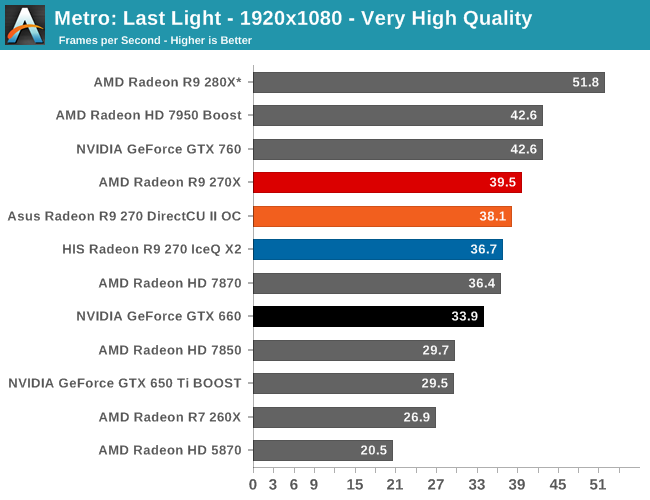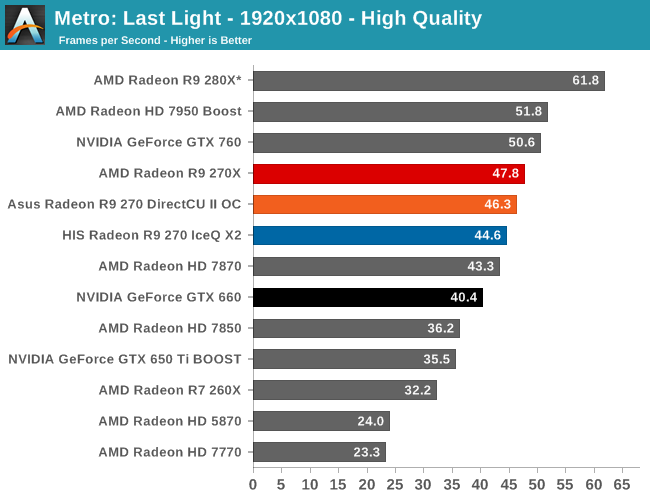The AMD Radeon R9 270X & R9 270 Review: Feat. Asus & HIS
by Ryan Smith on November 13, 2013 12:01 AM ESTMetro: Last Light
As always, kicking off our look at performance is 4A Games’ latest entry in their Metro series of subterranean shooters, Metro: Last Light. The original Metro: 2033 was a graphically punishing game for its time and Metro: Last Light is in its own right too. On the other hand it scales well with resolution and quality settings, so it’s still playable on lower end hardware.


AMD likes to pitch the 270 series as their primary 1080p cards, and although they generally do a perfectly fine job at it, Metro is a reminder that there are scenarios where they will come up short, particularly if trying to do 1080p at the highest quality settings. For these cards if we want framerates better than the 30s, we have to look at moving down a quality level.
At 1080p high quality, we can get our 270 cards up to the mid-40fps range. 270X of course leads the pack, but the 270 cards are very close behind owing to the fact that the only difference between the cards is the GPU clockspeed.
For the 270X in particular we’re looking at performance just a few frames per second behind the more expensive GTX 760, for a deficit of 6%. Otherwise the only cards close to it are of course the 270, and the outgoing 7870.
As for our 270 cards, they are second only to the 270X in anything near their price. The Asus card with its factory overclock is as to be expected faster, essentially splitting the difference between the stock clocked HIS 270 and the 270X. Furthermore in this test both cards are faster than the 7870 – a Pitcairn card with higher clockspeeds – showing the potency of the memory clockspeed increase. Finally, both cards are 10%+ faster than the GTX 660, making this an easy win for AMD.










59 Comments
View All Comments
Will Robinson - Wednesday, November 13, 2013 - link
What!...no hatchet job on these new cards from Wreckage?The hurt just keeps on coming eh Wrecky?
just4U - Thursday, November 14, 2013 - link
It's not beating the 760 so his stocks are safe... for now. Besides, you need to give him a break. Poor man must be tired after the release of the 780Ti and 290/X.geniekid - Wednesday, November 13, 2013 - link
Would really have liked to see CFX numbers.Da W - Wednesday, November 13, 2013 - link
Agreed, i need to compare 270X crossfire performance/heat/noise to a single 290X.Right now i'm hesitating, for my 3 monitor setup:
1. Dual 270X for 400$. -Advantage of lower cost, lower heat, lower noise, turn off one GPU when not gaming. Don't know if it's strong enough for 3600X1920.
2. Single 290 for 450$. -Best price/performance, noisy, hot.
3. Single GTX 780 superclocked for 530$. - If only for Nvidia cooler and energy efficiency, else i'm an AMD guy.
4. Single 290X for 550$. -I would pick this over vanilla 290 for chip binning, it should have higher quality GPU as far as energy concumption goes.
Titan and 780ti are above my budget.
garadante - Wednesday, November 13, 2013 - link
I'm strongly doubting two of these would game at 3600x1920 comfortable. That's almost 4k resolution. Remember that any AMD card below the 290 series still uses the Crossfire bridge and can't transfer 4k resolution frame buffers through it. Making the second card completely useless as the buffer is just dropped instead. And I haven't seen technical info yet, but I wonder if that's part of the reason why the 290 series outperforms the 780/780 Ti in 4k gaming so well. Perhaps the SLI bridge is also becoming a bottleneck, depending on how it handles frame buffers.For that resolution, personally I'd say waiting for aftermarket 290s and 290Xs would be a good choice. Get either much better binned chips in a high end aftermarket 290 or 290X, better thermals, and acoustics for both (and thus better overclocking headroom). With the performance those cards were getting at 4K gaming, they could probably handle single card 3600x1920 at decent settings, though probably not highest without dropping significantly below 60 FPS. But it leaves room for adding a 2nd card, whereas starting with 270X doesn't. Looks like it only has 1 Crossfire bridge which means you can't add a third card.
Da W - Wednesday, November 13, 2013 - link
Good advice. I'll discard option number 1 then, and yes i'm waiting until we see custom coolers on the 290 series before i make a move, probably an MSI one to match my MB. Although that Nvidia cooler is cool looking as hell.....At "3.5K", i find that disabling AA or adjusting just a step below "ultra freaking high details" makes all games playable. By playable i mean above 30FPS.
krumme - Wednesday, November 13, 2013 - link
Where is the noise equalization test?It looks like the asus card is around 853% faster than the nearest competitor.
Streetwind - Wednesday, November 13, 2013 - link
Ryan, will you be adding the results from the various R7/R9 models tested in the last month or two to Bench eventually? The entire new series is absent so far, as is the GTX 780 Ti. I often use Bench for comparing my current card to potential upgrades, so it would be great to have.Ryan Smith - Wednesday, November 13, 2013 - link
Yes. GPU14 Bench will be up next week; I need to clean up the DB a bit first.yacoub35 - Wednesday, November 13, 2013 - link
So how come no mention of the 7950 in the conclusion? It's clearly the right choice, as you get 3GB of VRAM in addition to superior performance, and all for a price well under $200.